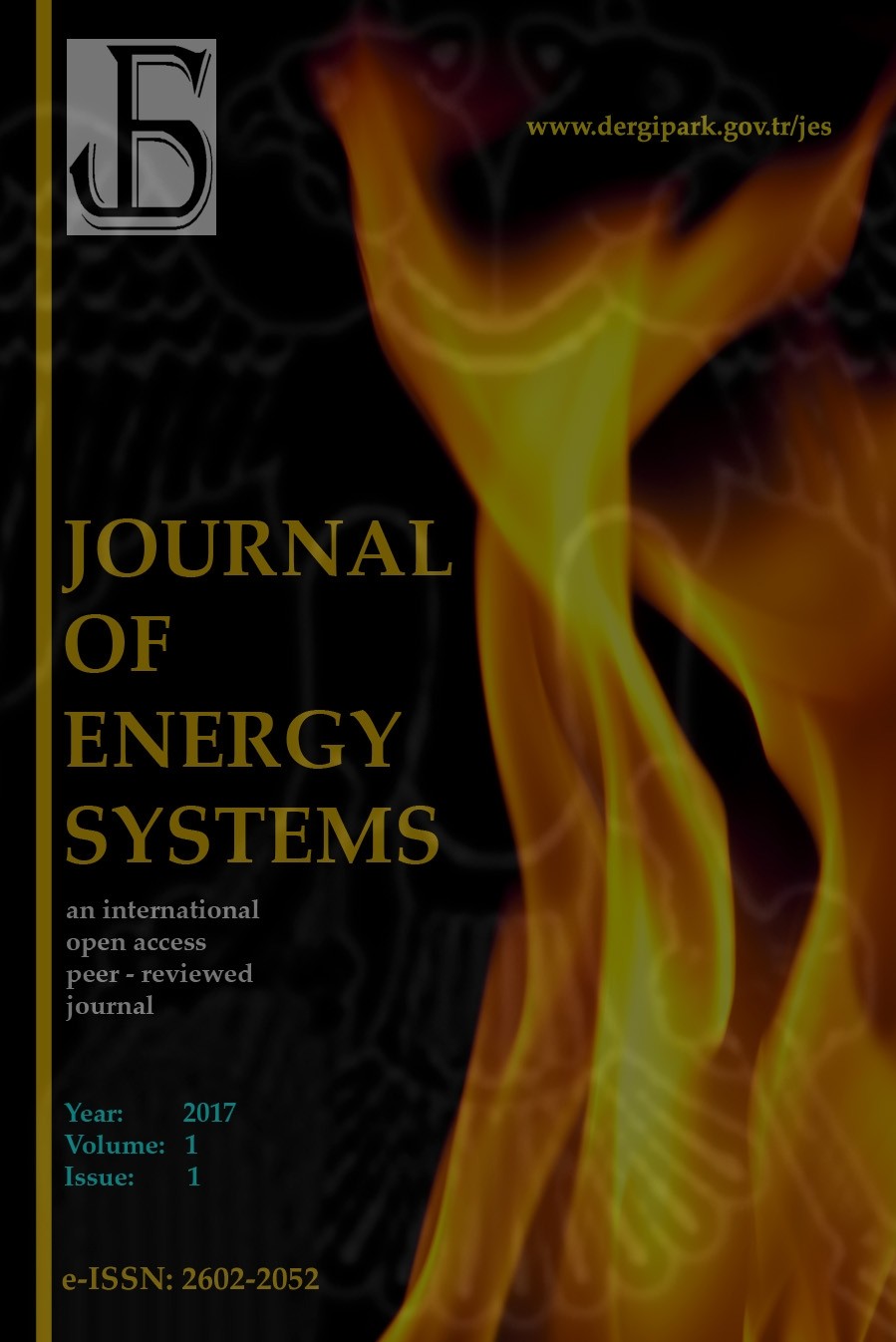Sensitivity analysis for piezoelectric energy harvester and bluff body design toward underwater pipeline monitoring
Sensitivity analysis for piezoelectric energy harvester and bluff body design toward underwater pipeline monitoring
Wireless Sensor Nodes, bluff body piezoelectric energy harvester, underwater pipelines, performance impact,
___
- J. Heidemann, M. Stojanovic, M. Zorzi, Underwater sensor networks: applications, advances and challenges, Phil Trans R Soc A, 370(1958), 158–175, 2012.
- C.C. Elam, C.E. G. Padró, G. Sandrock, A. Luzzi, P. Lindblad, E.F. Hagen, Realizing the hydrogen future: the International Energy Agency’s efforts to advance hydrogen energy technologies, Int. J. Hydrog. Energy, 28(6), 601–607, 2003.
- A.K. Akella, R.P. Saini, M.P. Sharma, Social, economical and environmental impacts of renewable energy systems, Renewable Energy, 34, 390-396, 2009.
- O. Ercoskun, S. Karaaslan, Guidelines for ecological and technological built environment: a case study on Güdül-Ankara, Turkey, Gazi Univ. J. Sci., 24(3), 617–636, 2011.
- I.F. Akyildiz, W. Su, Y. Sankarasubramaniam, E. Cayirci, Wireless sensor networks: a survey, Comput. Netw., 38(4), 393–422, 2002.
- F.U. Qureshi, A. Muhtaroglu, K. Tuncay, A method to integrate energy harvesters into wireless sensor nodes for embedded in-pipe monitoring applications, 5. Int. Conf. Energy Aware Computing Systems & Applications (ICEAC), 24-26 March 2015, 1–4.
- M. Lubieniecki, T. Uhl, Integration of thermal energy harvesting in semi-active piezoelectric shunt-damping systems, J. Electronic Materials, 44(1), 341-347, 2015.
- S. Firat, Application of efficient and renewable energy technologies in low cost buildings and construction, J. Polytech., 17(1), 1-2, 2014.
- R.N. Silva, L.M. Rato, J.M. Lemos, F. Coito, Cascade control of a distributed collector solar field, J. Process Control, 7(2), 111–117, 1997.
- M.A. Ahmad, Piezoelectric water drop energy harvesting, J. Electron. Mater., 43(2), 452–458, 2013. S. Pobering, N. Schwesinger, Power supply for wireless sensor systems, IEEE Sensors Conf., 685–688, Lecce (Italy), 26-29 Oct. 2008.
- J.F. Kazienko, I.G. Ribeiro, I.M. Moraes, C.V.N. Albuquerque, Practical evaluation of a secure key-distribution and storage scheme for wireless sensor networks using TinyOS, CLEI Electronic Journal, 14(1), paper 8, 2011.
- M. K. Stojcev, M. R. Kosanovic and L. R. Golubovic, Power management and energy harvesting techniques for wireless sensor nodes, 9. Int. Conf. Telecommunication in Modern Satellite, Cable, and Broadcasting Services, Nis (Serbia), 7-9 October 2009.
- H.D. Akaydin, N. Elvin, Y. Andreopoulos, Energy harvesting from highly unsteady fluid flows using piezoelectric materials, J. Intell. Mater. Syst. Struct., 21(13), 1263–1278, 2010.
- J. Qiu, H. Jiang, H. Ji, K. Zhu, Comparison between four piezoelectric energy-harvesting circuits, Front. Mech. Eng. China, 4(2), 153–159, 2009.
- G.K. Ottman, H.F. Hofmann, A.C. Bhatt, G.A. Lesieutre, Adaptive piezoelectric energy harvesting circuit for wireless remote power supply, IEEE Trans. Power Electronics, 17(5), 2002.
- P. M. Glatz, L. B. Hörmann, C. Steger, and R. Weiss, Designing perpetual energy harvesting systems explained with rivermote: a wireless sensor network platform for river monitoring, Electronic J. Structural Engineering, 55–65, 2010.
- N. Mohamed, I. Jawhar, J. Al-Jaroodi, L. Zhang, Sensor network architectures for monitoring underwater pipelines”, Sensors, 11, 10738-10764, 2011, doi:10.3390/s111110738.
- H.A. Sodano, D.J. Inman, G. Park, Generation and storage of electricity from power harvesting devices, J. Intell. Mater. Syst. Struct., 16(1), 67–75, 2005.
- Q. Wen, R. Schulze, P. Streit, D. Billep, T. Otto, T. Gessner, The design of vortex induced vibration fluid kinetic energy harvesters, Proceed. PowerMEMS, Atlanta (USA), 2-5 Dec 2012.
- E. Bischur, S. Pobering, M. Menacher, N. Schwesinger, Piezoelectric energy harvester operating in flowing water, Proceed. SPIE, 7643, 76432Z–8, 2010.
- M.S. Bhuyan, B.Y. Majlis, M. Othman, S.H.M. Ali, C. Kalaivani, S. Islam, Development of a fluid actuated piezoelectric micro energy harvester: finite element modeling simulation and analysis, Asian J. Sci. Res., 6(4), 691–702, 2013.
- M.S. Bhuyan, B.Y. Majlis, S.H.M. Ali, M. Othman, M.S. Islam, Modeling and finite element analysis of a micro energy harvester, Int. Conf. Multimedia, Signal Processing and Communication Technologies (IMPACT), 293–296, Aligarh, 23-25 Nov. 2013.
- D-A Wang, H-H. Ko, Piezoelectric energy harvesting from flow-induced vibration, J. Micromechanics Microengineering, 20(2), 25019, 2010.
- S. Pobering and N. Schwesinger, A novel hydropower-harvesting device, Proceed. Int. Conf. MEMS, NANO and Smart Systems (ICMENS), 480–485, 2004.
- Başlangıç: 2017
- Yayıncı: Erol KURT
Structural Behaviour of Ferrocement Panels Under Radiant Heating
Wail AL-RİFAİE, Ahmad K. ABDUL-RADA
Fassahat Ullah Qureshi QURESHİ, Ali MUHTAROĞLU, Kagan TUNCAY
Wind energy storage by pumped hydro station
Mariem NACİRİ, Mohammed AGGOUR, Wassima AİT AHMED
Aamir MEHMOOD, Zafar SAİD, Adeel WAQAS, Waseem ARSHAD
Control of dual stator induction generator integrated in wind energy conversion system
Meryem BENAKCHA, Leila Benalia, Fatima Ameur, Djamel Eddine Tourqui
